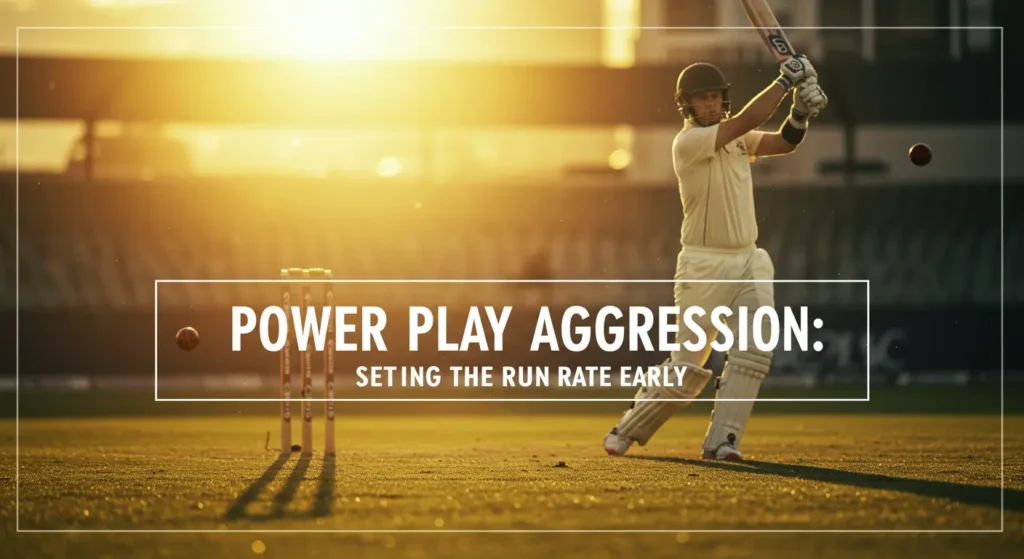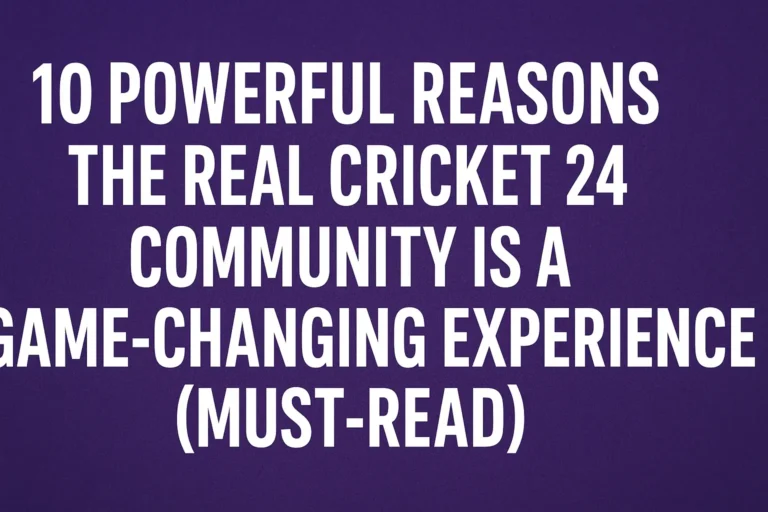Scoring 350 runs in an ODI match in RC 25 feels like chasing a mountain. At first glance, the target looks intimidating, especially on Hard difficulty settings, where bowlers rarely give easy deliveries. Yet, with the right mindset, tactical planning, and consistent execution, building such a monumental score becomes not only possible but repeatable.
Think of it like constructing a skyscrape, you cannot rush the first floor, or the entire structure collapses. In the same way, a perfect innings blueprint for crossing 350 in Real Cricket 25 involves patience in the beginning, acceleration in the middle, and unleashing full power during the death overs. By applying batting dominance strategy and understanding every phase of the match, you can transform a decent score into a record-breaking ODI innings.
This guide walks you step by step through scoring big runs in 50-over matches, making sure you build innings smartly while keeping wickets intact.
Building a Solid Foundation (First 10 Overs Strategy)
The first 10 overs—also known as the Powerplay 1—set the rhythm of your innings. With only two fielders allowed outside the 30-yard circle, this is the golden window to create momentum.
- Start with aggressive openers who have high Power and Timing.
- Target loose balls early to boost the run rate to around 6.5–7 per over.
- Avoid risky lofted shots when bowlers are fresh. Instead, play along the ground with perfect timing.
This is where you should focus on conserving wickets while scoring fast. An early collapse destroys the foundation, making it impossible to push later. By blending caution with controlled aggression, you set up the perfect launch pad for pacing your innings for 350+ runs.
Powerplay Aggression: Setting the Run Rate Early

Once you’re comfortable with the pitch conditions and bowlers’ rhythm, it’s time to switch gears. Run acceleration techniques RC25 play a huge role here.
- Focus on targeting specific bowlers and overs—especially medium pacers who lack swing.
- Use Batting Meters wisely: stay in the green zone for safe shots but push into the red zone when the field is up.
- Keep rotating strike; don’t let bowlers settle.
Maintaining a 7+ run rate throughout 50 overs is the ultimate secret to reaching 350. If you achieve around 70–80 runs in the first 10 overs, you’ve built an excellent foundation for a massive total.
Middle Overs Control: Rotating Strike and Finding Gaps
The period between Overs 11–40 often decides whether you’ll post 280 or smash past 350. Many players slow down here, but this is the time to construct partnerships.
- Place an Anchor Batsman at the crease. This player must have strong Technique and Temperament to bat long.
- The partner plays as a strike rotator, converting singles into doubles and punishing bad deliveries.
- Use field placements to your advantage—most teams spread the field, leaving gaps in the covers or square leg.
This is also where you should think about player stamina and fatigue management. Don’t overuse power shots or your batsmen will tire early. By keeping wickets intact during this stage, you prepare for an all-out assault in the final overs.
Utilizing Power Hitters in the Death Overs

The magic often happens in the last 10 overs. With set batsmen at the crease, you can double your total in a blink.
- The role of Finishers is crucial here. These players possess high Power and Strike Rotation skills.
- Overs 41–45 (Powerplay 2) bring back field restrictions, so exploit the gaps over mid-off and mid-on.
- From Overs 46–50, unleash everything: lofted shots, sweeps, switch hits, and slog sweeps.
At this stage, your goal should be 100–120 runs in the last 10 overs. By combining aggression with calculated risk-taking, you ensure your perfect innings blueprint converts into a 350+ masterpiece.
Shot Selection: Balancing Risk and Reward
Every cricket gamer knows that bad shot selection is the number one reason for getting out. In RC 25, this becomes even more critical because timing directly affects your dismissal chances.
- Stick to ground shots until you’ve faced 15–20 balls.
- Use lofted shots only when bowlers miss their line or during field restrictions.
- Choose areas where you’re comfortable—don’t try risky reverse sweeps unless you’ve mastered them.
Remember, the art of building a massive ODI innings isn’t about wild hitting. It’s about smart, calculated decisions that minimize risk while maximizing scoring opportunities.
Running Between Wickets: Converting 1s into 2s
Often overlooked, running between wickets makes a huge difference in reaching 350. Even in a video game, quick doubles keep the score ticking and pressure the fielders.
- Always be ready to sprint after nudging the ball into the gaps.
- Train yourself to anticipate throws and judge fielder speed.
- Mix singles and doubles with boundaries to maintain rhythm.
This small habit prevents your innings from stagnating and ensures your batting for 50 overs guide remains balanced.
Bowling Weaknesses: Targeting Opposition’s Weak Bowlers
A high score is not just about your batting—it’s about exploiting the opposition’s weakest link.
- Identify bowlers with lower stamina or poor economy early on.
- Target spinners in middle overs if they lack variations.
- Save aggressive shots for fifth and sixth bowlers who usually leak runs.
By systematically dismantling weaker bowlers, you maintain momentum without taking unnecessary risks against strike bowlers. This is the essence of a RC25 batting dominance strategy.
Player Roles: Anchors vs Aggressors in the Lineup
Your team composition heavily influences your ability to reach 350. Balance is everything.
- Aggressive Openers: Provide quick starts in Powerplay.
- Anchor Batsman: Holds one end, plays 40+ overs if possible.
- Finishers: Explode in the last 10 overs.
When these roles are clearly defined, you can manage scoring pressure effectively. A lineup without an anchor often collapses, while one without finishers cannot accelerate at the death.
Managing Wickets: When to Accelerate vs When to Consolidate
Knowing when to go big and when to hold back is the hallmark of a champion.
- If you lose 2 wickets inside the first 10 overs, consolidate until over 20.
- If you’re 150/1 after 25 overs, that’s the perfect time to accelerate.
- Don’t waste your set batsman—guard him at all costs.
Smart wicket management ensures that you don’t crumble under scoreboard pressure, keeping your ODI batting strategy for huge totals intact.
Practice Tips: Perfecting Your 350+ Run Chase/Setting
No master ever succeeded without practice. To consistently score 350+ in RC 25, you need to refine your skills regularly.
Here are 5 actionable tips:
- Experiment with Batting Settings – Test which camera angle and controls suit you best for ODI matches.
- Play Scenario Matches – Practice batting for 50 overs instead of just T20 style slogs.
- Study Opposition Bowlers – Learn their pace, spin variations, and weak zones.
- Master Strike Rotation – Don’t let dot balls build pressure; learn nudges and deflections.
- Challenge Yourself – Try scoring 350+ on Hard difficulty. Once you master that, Pro mode feels easy.
Consistent training sharpens reflexes and builds the confidence needed for milestone scoring in cricket games.
Conclusion
Reaching 350 runs in an ODI match in RC 25 isn’t a miracle, it’s the outcome of smart planning, disciplined execution, and consistent practice. By mastering from powerplay to death overs batting, carefully managing stamina, and playing roles according to each player’s strengths, you transform ordinary scores into match-winning totals.
When you next step onto the virtual pitch, remember this: a solid foundation + controlled middle overs + explosive finish = unstoppable success. With this guide, you’re fully equipped to dominate bowlers and create record-breaking innings every time.
For more inspiration on batting techniques and strategies in cricket, you can also check ESPN Cricinfo’s ODI batting insights.






